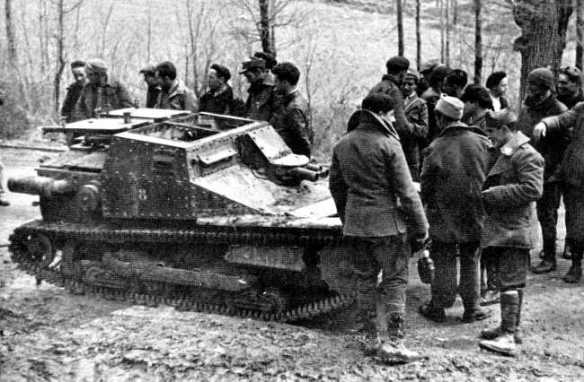Republican forces with a captured CV33 at the battle of Guadalajara, March 1937.
On 5 February, Italian detachments took part in operations around the city of Malaga, part of a new Nationalist offensive along the entire front. Malaga was taken on the 8th, and Italian units occupied the nearby towns of Nerja and Motril. As a result of their success here, the Italians overestimated the chances for a quick, decisive victory, and launched a major offensive on 8 March. Two infantry divisions, each supported by two tank companies, took the field to find that the terrain had become a vast expanse of thick sticky mud because of heavy rains that fell the night before. This considerably limited the mobility of the Italian armor.
On the following day, two Italian tank units advanced to a point about 30 kilometers outside Guadalajara. In various skirmishes, the Republicans lost nine of the 22 tanks they employed. Both sides consumed enormous amounts of fuel because of the difficult terrain, and fuel supplies were often delayed because of congestion along the supply routes.
In an attempt to slow the Italian advance, the Republicans placed two BT-5s along their withdrawal route as part of their rear guard, but one of these was destroyed. By 9 March, the Italians had occupied Brihuega, but on the same evening, six BT-5s set up an ambush in the outlying forest. No sooner had the Third Italian Division, supported by two tank companies and the armored car company, begun its movement at dawn the next day, but they fell into the trap. The Soviet tanks fired their cannon and machine guns at nearly point-blank range. They destroyed two tanks and inflicted many casualties. The Lancia armored car company, functioning as a reconnaissance unit, also suffered heavy losses – at least three of its vehicles were captured and used by the enemy.
On the next day, 11 March, three flamethrower tanks rushed to assist an infantry column that had run into a series of enemy machine gun nests near Trijueque. One tank was hit after having suppressed some of the positions, another overturned when it rolled off the roadbed, and a third was destroyed by an antitank round. A second lieutenant moved up in his own tank in an attempt to extract any survivors. Hit by a round from a BT-5, which severed his arm, he managed to bring his vehicle safely back to friendly lines before he died. Another tank conducting reconnaissance operations in the direction of Torjia was also hit, but it too was brought back into operation. Two other tanks were destroyed by 45-mm rounds from the BT-5s. Obviously, the Italian tanks with their 8-mm machine guns were no match for the BT-5s once they got within range.
The Italians then launched a combined attack of armor and infantry, but this was stopped by Republican heavy artillery and air forces. By 12 March, Palacio Ybarra was the point of maximum penetration towards Guadalajara. It was here that the pro-Republican “Garibaldi” Battalion, made up of anti-Fascist Italian volunteers, routed the Nationalists with the help of two BT-5s. Not far away, at Los Yebenes, the 4th Italian Division (Littorio) relieved the 3d. On 13 March, two BT-5s again ambushed the Italians, although they were eventually destroyed.
On 18 March, the Republicans began a counteroffensive. In preparation, they had drawn men and materiel from other units to amass at least 60,000 troops and 60 tanks. The Italians facing them totaled about 30,000 men. The Republicans immediately moved their tanks up front, placing about 40 of them in the Brihuega area. Well-supported by artillery and about 80 aircraft, they began their attack that afternoon. That night, the Republicans reoccupied Brihuega and forced the Italians to fall back several kilometers. Meanwhile, the Italian tanks stood idle for lack of fuel. The fighting stopped in a stalemate on 21 March, even though the Italians had advanced about 20 kilometers from their original positions of 8 March.
After reorganizing at Villasante, the Italians also participated in operations along the Bay of Biscay, an area stubbornly controlled by pro-Republican Basque forces. The Basques had established a strong defense around the city of Bilbao. The Italians attacked on 28 April, beginning a long battle around the city. On 15 June, Italian tanks attacked the Basque defensive positions at a weak point that had been revealed by a deserter. On 19 June, they entered and occupied Bilbao, which had already been evacuated by its defenders.
Armor Limitations
In general, Italian combat vehicles used in the Spanish Civil War were handicapped by the inferiority of their armament. They were no match for the heavier enemy tanks, armed with rapid-fire 37- mm and 45-mm weapons on rotating turrets. There were other equipment problems as well; for example, the air intake systems on the tanks and armored cars were not equipped with appropriate filters to protect crewmen from the fine dust so prevalent in the Spanish countryside. In an attempt to protect their faces and mouths from the dust, the Italians adapted their gas masks to serve as dust protectors, but to little avail.
Italian tankers in Spain faced conditions radically different from those of the Ethiopian War of 1935- 36, in which the poorly-equipped Ethiopians were overwhelmed by a relatively modern Italian Army. The Italians found the tables turned against them in Spain, and this was reflected in the relatively high level of their casualties. Even more significant, however, was that the Italian General Staff failed to draw any useful lessons in tank warfare from the Spanish experience. Accordingly, when Italy entered WWII in 1940, her armored units -still comprised mainly of CV 3/35, although they were renamed L3s – would face tanks even more formidable than the BT-5 or the T-26B, and the results on the battlefield were to be disastrous.
